Photographs: Ajay Verma/Reuters Surinder Sud
About 53 per cent of the fertiliser subsidy goes to these small and marginal farmers though they cultivate only around 44 per cent of the cropped land, writes Surinder Sud
The Prime Minister's Economic Advisory Council has suggested in its recent Economic Outlook report for 2012-13 that the process of reducing the subsidy burden on the exchequer could begin with 'dismantling the fertiliser subsidy'.
To justify this plea, the PMAEC has reportedly argued that agricultural input subsidies are progressively losing their relevance because their role in contributing to productivity enhancement is fast diminishing.The PMAEC's arguments are, indeed, far from incontrovertible.
For, several widely held perceptions concerning the fertiliser subsidy, its relevance to agriculture and its ultimate beneficiaries do not seem to be well founded.
. . .
Subsidy is fine but is it a burden or boon?
Image: A farmer sleeps next to a sugarcane field in the village of Dumchhedi in Punjab.Photographs: Ajay Verma/Reuters
This is borne out by a well-researched working paper (No 2012-09-01) brought out by the Indian Institute of Management, Ahmedabad, earlier this month.
Based largely on the analysis of government data, the author of this paper, Professor Vijay Paul Sharma, has dispelled the prevalent notion that fertilisers are used mainly by large farmers who also corner a bulk of the fertiliser subsidy.
Likewise, this paper has demolished the impression that the use of fertilisers is chiefly confined to irrigated crops and that tillers of rainfed land don't benefit from the fertiliser subsidy.
Moreover, this in-depth study finds that doing away with the fertiliser subsidy would render farming unviable, especially for small and marginal farmers, in some agriculturally-underdeveloped states.
. . .
Subsidy is fine but is it a burden or boon?
Image: A farmer ploughs his paddy field in Kadamtala village, about 189 km (117 miles) north of Agartala.Photographs: Jayanta Dey/Reuters
Regarding the better targeting of the fertiliser subsidy, which could be one of the options for the government to cut down its subsidy bill, the paper argues that this might pose the kind of glitches that are encountered while targeting food subsidy.
There could be grave errors in identifying the intended recipients, leaving out many needy farmers, notably tenant farmers who constitute a sizable section of the Indian farm community.
The IIM report has, in fact, preferred 'rationing' of fertilisers over 'targeting', though even this plea seems debatable.
. . .
Subsidy is fine but is it a burden or boon?
Image: A farmer works in a pulse farm at Bakrol village on the outskirts of Ahmedabad.Photographs: Amit Dave/Reuters
Analysing the data generated by the all-India input surveys conducted by Krishi Bhawan's agricultural census division, the study has inferred that small and marginal farmers use higher amounts of fertilisers per hectare than their larger counterparts and, thus, get a relatively bigger slice of the overall fertiliser subsidy.
About 53 per cent of the fertiliser subsidy goes to these small and marginal farmers though they cultivate only around 44 per cent of the cropped land.
More surprisingly, marginal farmers operating tiny farms apply nearly twice the quantities of chemical plant nutrients, estimated at 140 kg per hectare, than large farmers that use, on average, 68 kg per hectare.
. . .
Subsidy is fine but is it a burden or boon?
Image: Kashmiri farmers thresh paddy on a drum during the harvest in Shariefabad on the outskirts of Srinagar.Photographs: Fayaz Kabli/Reuters
Thus, even these resource-poor farmers benefit from the fertiliser subsidy.
Notably, the rate of increase in fertiliser use, too, is far higher in the case of small farmers compared to large farmers.
Between 1996-97 and 2006-07, the highest increase of 55.4 per cent was accounted for by small farmers, followed by nearly 44 per cent by semi-medium farmers, against merely 32.2 cent growth in fertiliser consumption by large farmers.
An important lesson that can be learnt from this IIM report is that hasty, half-baked and improperly-implemented moves on the subsidy front can prove counterproductive.
The nutrient-based subsidy regime is a case in point.
. . .
Subsidy is fine but is it a burden or boon?
Image: Kashmir Singh, 56, a farmer, inspects his sunflower crop in a field at Dharar village on the outskirts of the northern Indian city of Amritsar.Photographs: Munish Sharma/Reuters
Though this concept is theoretically sound, its flawed enforcement has rendered it counterproductive.
While the prices of non-urea fertilisers have been decontrolled and subjected to subsidy cuts, urea -- the most consumed fertiliser -- has been left out of this system.
As a result, while the farm gate prices of phosphatic and potassic fertilisers have soared, more than doubling in some cases, those of urea have risen only marginally, widening further the price differential between urea and non-urea fertilisers.
This has, predictably, encouraged higher use of urea at the cost of phosphates and potash, worsening the imbalance in the nutrient use that is perilous for soil fertility and crop productivity.
Given the far-reaching policy implications of this study, the government would be well advised to keep them in view while revisiting the fertiliser subsidy issue.

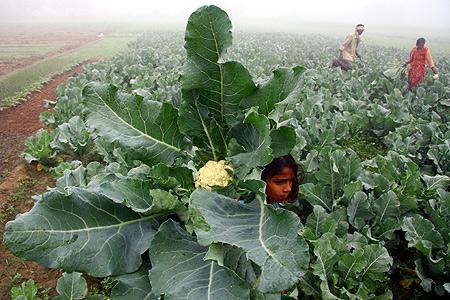
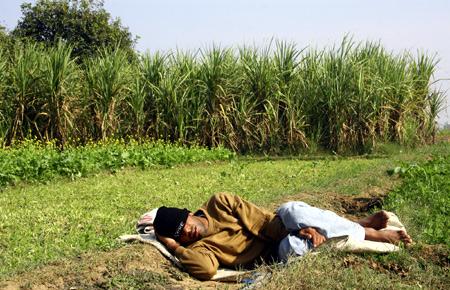
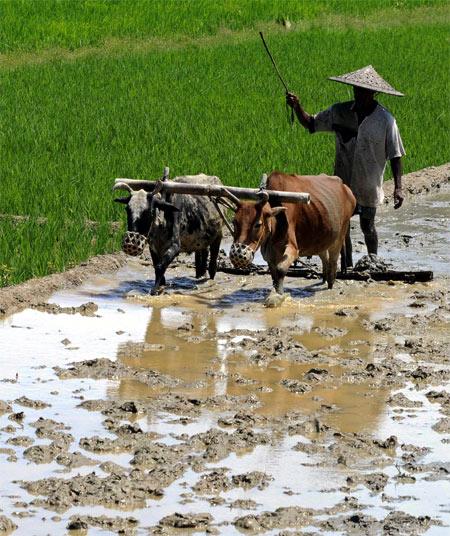
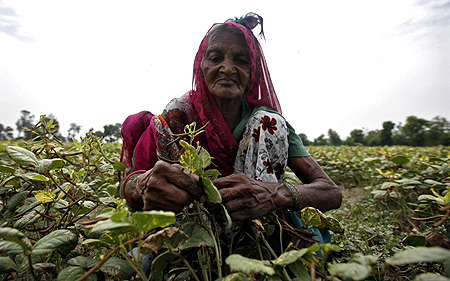
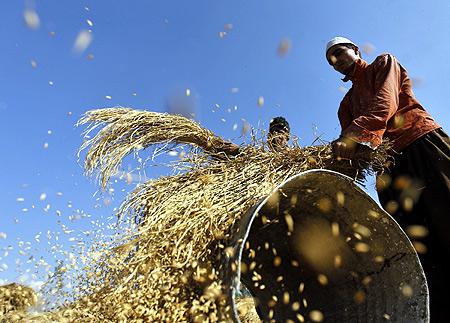


article